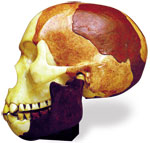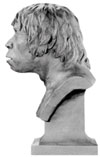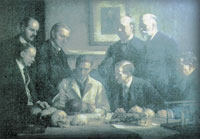 |
False fossil Piltdown man was pictured like this in the British press. |
 |
Piltdown Man was nothing but a hoax perpetrated by cementing an ape jaw to a human skull. |
A well-known doctor and also an amateur paleoanthropologist, Charles Dawson came out with an assertion that he had found a jawbone and a cranial fragment in a pit in Piltdown, England in 1912. Even though the jawbone was more ape-like, the teeth and the skull were like a man's. These specimens were labelled the "Piltdown Man". Alleged to be 500,000 years old, they were displayed as an absolute proof of human evolution in several museums. For more than 40 years, many scientific articles were written on the "Piltdown Man", many interpretations and sketches were made, and the fossil was presented as an important piece of evidence of human evolution. No less than five hundred doctoral theses were written on the subject.63
In 1949, Kenneth Oakley from the British Museum's paleontology department attempted to try the method of "fluorine testing", a new test used for determining the date of some old fossils. A trial was carried out on the fossil of the Piltdown Man. The result was astounding. During the test, it was realised that the jawbone of the Piltdown Man did not contain any fluorine. This indicated that it had remained buried for no more than a few years. The skull, which contained only a small amount of fluorine, showed that it was only a few thousand years old.
 |
The bust of the Piltdown Man which was once displayed in museums. |
Detailed research revealed that Piltdown man was the biggest science fraud in history. This was an artificial skull; the cranium belonged to a 500-year-old man, and the mandibular bone belonged to a recently dead ape! The teeth were thereafter specially arranged in an array and added to the jaw, and the joints were filed in order to resemble that of a man. Then all these pieces were stained with potassium dichromate to give them an ancient appearance.
 |
The Piltdown hoax being exposed by the fluorine test. |
Le Gros Clark, who was in the team that disclosed the forgery, could not hide his astonishment at this situation and said that "the evidences of artificial abrasion immediately sprang to the eye. Indeed so obvious did they seem it may well be asked - how was it that they had escaped notice before?"64
In the wake of all this, "Piltdown Man" was hurriedly removed from the British Museum where it had been displayed for more than 40 years.
The Piltdown scandal clearly showed that there was nothing that evolutionists would stop short of doing in order to prove their theories. Moreover, this scandal showed that evolutionists had no findings to reinforce their theories. Since they have no evidence, they prefer to fabricate it themselves.
65) Malcolm Muggeridge, The End of Christendom, Grand Rapids, Eerdmans, 1980, S. 59.
66) Stephen Jay Gould, "Smith Woodward's Folly", New Scientist, 5 April 1979, S. 44